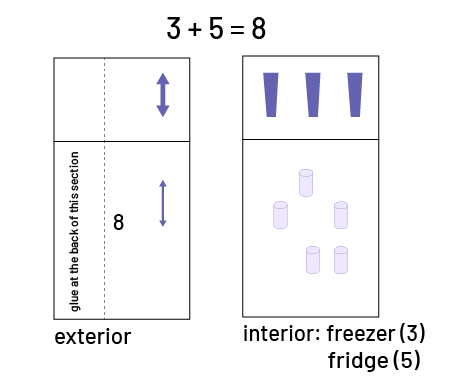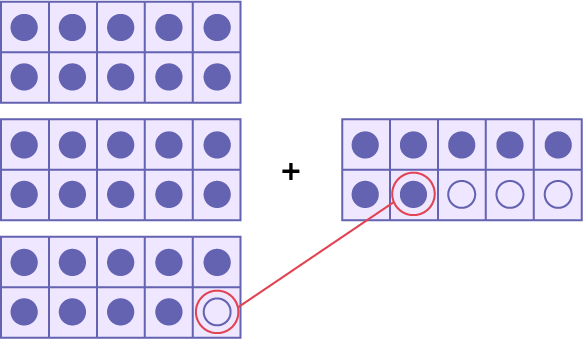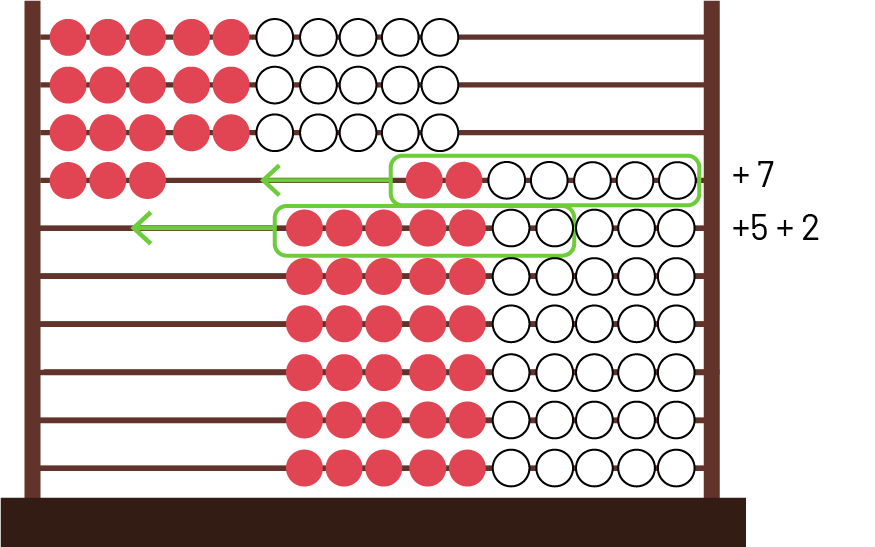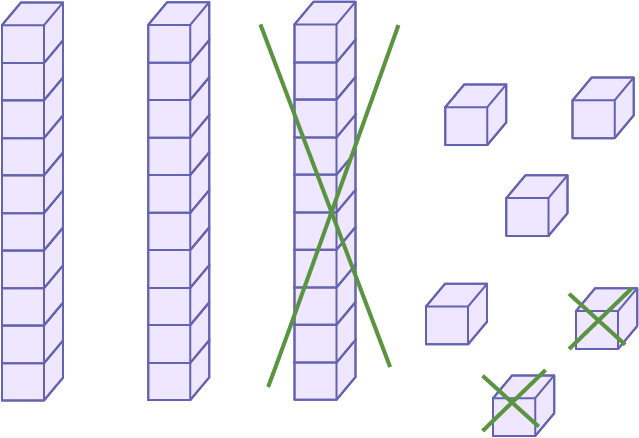B2.4 Use objects, diagrams, and equations to represent, describe, and solve situations involving addition and subtraction of whole numbers that add up to no more than 50.
Activity 1: Addition and Subtraction Problems
Materials
- reusable plastic bags (one per student)
- wooden sticks (five per student)
- markers
- stickers
Give each student a plastic bag and five wooden sticks.
Have them decorate the sticks with markers or stickers to represent five characters.
Suggest that students use their characters to simulate the problems that will be presented to them.
Substitute the names in the stated problems with names of students in the class.
Sample Problem
James, Julie, and Corinne are thirsty. They go to the fountain to drink. How many people are at the fountain? Renee and Jamal also decide to go and drink. How many people are at the fountain now?
Write the corresponding number sentence on the board (3 + 2 = 5).
Suggest other such problems, including subtraction problems.
Invite students to act out the story by standing in a line near the reading or math corner, for example, or to illustrate the problem using the characters they have created.
Form teams of two and ask them to compose addition or subtraction problems featuring the characters created.
Invite them to present their problems to the class.
Source: translated from Guide d’enseignement efficace des mathématiques de la 1re à la 3e année, Numération et sens du nombre, p. 98.
Activity 2: Refrigerator Booklets
Materials
- Appendix 1SO.4 (Refrigerator Template) (one copy per student)
- glue sticks (one per student)
- grocery store advertising flyers
Provide a copy of Appendix 1SO.4 (Refrigerator Template) to each student.
Guide students through the following steps to prepare the refrigerator or ask for volunteers to do so before the activity begins:
- Cut out the outline of the refrigerator.
- Cut the solid line separating the refrigerator from the freezer to the dotted line.
- Apply glue to the back of the narrow part of the refrigerator (between the dotted line and the outline) and glue it to a piece of construction paper.
- Trace the outline of the refrigerator on the construction paper and draw a line to separate the refrigerator from the freezer.
- Fold the doors along the dotted line to open them.
Next, ask students to cut out small pictures of food from grocery store flyers.
Provide a number to write on the refrigerator door (for example, 8).
Have students glue pictures - one set behind the refrigerator (for example, 5 pictures) and another set behind the freezer (for example, 3 pictures). Together, these visual representations sum up the number (8) written on the door.
Finally, students should write a number sentence that represents the terms and the sum.

Assemble the students' illustrations to represent all the combinations of the number and create the "8" book.
Source: translated from Guide d’enseignement efficace des mathématiques de la 1re à la 3e année, Numération et sens du nombre, p. 99-100.
Activity 3: Hot Dog Stand
Materials
- Appendix 1SO.5 (Game Board - Hot Dog Cart) (one copy per student)
- Appendix 1SO.6 (spinner "plus/minus") (one spinner per team of two)
- small objects (about 40 per student)
- dice (one die per pair)
Prepare "plus/minus" spinners using Appendix 1SO.6.
Form teams of two and give each team a die and a plus/minus spinner.
Provide each student with a copy of Appendix 1SO.5 (Game Board - Hot Dog Cart) and approximately 40 objects.
Provide the following instructions:
- Place 15 objects on the board to represent people waiting in line to buy hot dogs.
- Rotate the plus/minus spinner to determine the operation to be performed.
- Roll the die to see how many people join or leave the line.
- Perform the operation by moving the objects.
- Take turns playing until one of the two lines disappears (because there is no one left) or the line reaches 30 or more people.
Enrich the task by asking students to create an addition or subtraction problem based on the hot dog cart. They can illustrate their problem on the game board.
Source: translated from Guide d’enseignement efficace des mathématiques de la 1re à la 3e année, Numération et sens du nombre, p. 100.
Activity 4: Numbers in the Water!
Materials
- cards numbered from 1 to 12
- illustration of a lake
- giant dice (three)
Directions
- Display numbers from 1 to 12 on the board or on an easel.
- Place an illustration of a lake under the numbers.
- The goal of the game is to put all the numbers in the water in order from 1 to 12.
- Roll the 3 giant dice and ask students to find a way (either by adding the numbers or subtracting them) to get a number to fall in the water.
Students can use two numbers or all three numbers obtained. For example, the target number is 5. The numbers rolled are 3, 6, and 2. Students can say 6 + 2 = 8, then 8 - 3 = 5, or simply 3 + 2 = 5.
Write the different student responses on the board.
If the target number cannot be found, roll the dice again. The game ends when all the numbers from 1 to 12 are in the water.
Questions to Ask
Before rolling the dice, ask students: What numbers would you like to get? Why?
Source: translated from L’@telier - Ressources pédagogiques en ligne (atelier.on.ca).
Activity 5: Addition of Whole Numbers
Example 1
During recess, Mrs. Smith sees 7 children on the large play structure and 29 children playing ball. How many children does she see in total?
STRATEGY
Addition Using Anchor Point 10 and Compensation

I represent 29 and 7 using ten frames. The number 29 is close to 30, so I remove one counter from the frame with 7 counters, leaving 6. I then add that counter to 29, which gives me another ten, so that makes 30. Now I have to add 30 and 6.
30 + 6 = 36
Example 2
In a garden, there are 47 flowers. 33 are tulips. The others are daffodils. How many daffodils are in the garden?
STRATEGY
Addition Using Composition

Using the Rekenrek, I represent the 33 tulips with 3 rows of 10 beads and 3 red beads on the 4th row. I need to add the daffodil beads to total 47 flowers.
I add the 7 beads from the 4th row to get to 40. Then I add the 5 red beads and 2 of the white beads from the 5th row to get to 47.
Afterwards, I add up all these added beads.
7 + 5 + 2 = 7 + 7 = 14
So, there are 14 daffodils in the garden.
Source: translated from En avant, les maths! 1re, CM, Nombres, p. 3-4.
Activity 6: Subtraction of Whole Numbers
Example 1
Throughout the year Anne created 39 pieces of art. She has given some of her art to her family members. She has 22 pieces left. How many pieces of art did she give to her family?
STRATEGY
Add to Subtract Using a 50s Grid
On the 50s grid, I circled the number 39, which is the number of artwork pieces Anne had at the start. I circled the number 22, which is the number of artwork pieces she has left. From 22, I leapt by 10, which is 32, leapt by 5 more, which is 37, and leapt by 2 more, which is 39.

\(\displaylines{\begin{align}22 + \mathord{?} &= 39 \\ 22 + 10 + 5 + 2 &= 39 \\ 22 + 17 &= 39\end{align}}\)
Anne gave 17 pieces of art to her family.
Example 2
Luke read 36 pages in his book, while Melissa read 12 fewer pages of the same book. How many pages did Melissa read?
STRATEGY
Subtract Using Place Values
I used the base 10 material to represent the 36 pages that Luke read. I took three sticks to represent 3 tens and added six small cubes (units) to represent 6 ones. From this amount, I took one stick and two units to represent the twelve pages that Melissa has not read. This leaves me with two sticks and four units, so two tens and four ones. Melissa has read 24 pages (36 - 12 = 24).

Source: translated from En avant, les maths! 1re, CM, Nombres, p. 3-4.
